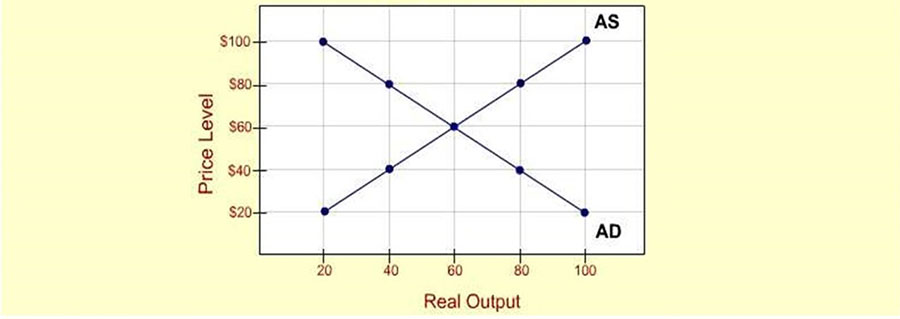Short-Run Equilibrium and Changes in AS/AD
Objective
Students will be able to:
- Identify factors affecting aggregate demand and aggregate supply.
- Graph changes in aggregate demand and aggregate supply.
- Use the ASAD model to draw conclusions about the macroeconomy.
Concepts

In this economics lesson, students will examine changes in aggregate demand and aggregate supply.
Procedure
Warm-Up
Ask students to use their understanding of aggregate demand and aggregate supply to draw an ASAD model with both lines on the same graph. Have them identify the point where the two lines cross on an ASAD model. (It represents equilibrium for the entire economy showing the price level and output for the whole economy). Remind students that the equilibirum point for supply and demand would change when certain variables changed. Tell them the same is true for equilibrium with the ASAD model. Have them brainstorm some potential variables that would affect the location of the supply and demand lines (preferences, government rules/regulations, income levels, etc.). Tell them they will use this information to examine changes in ASAD equilibrium.
Modeling
Explain that ASAD model is one of the most essential tools in macroeconomics because it brings all macroeconomic factors together in one diagram. Use the Aggregate Demand and Aggregate Supply Short-run Equilibrium Slides with notes to present the lesson to students. Slides 2 and 3. Briefly review AD. Slide 4. Explain that several factors can change AD. These changes result from increases or decreases in consumer expenditures, investment spending, government spending or net exports. Listed here are the factors that can impact those levels of spending and, in turn, impact AD. Note the importance of changes in fiscal and monetary policies. Do you think government actions could also influence other areas of spending? If so, how? (Answers will vary, but students should agree that changes in government policies or actions – tariffs, quotas, pandemics, military actions, etc. – can influence AD). Slides 5 -7. Briefly review AS. Slide 8. Explain that two primary factors influence AS: 1) changes in productive resources (land, labor, capital and entrepreneurship) will change the overall output in the economy, as reflected in AS; reflects changes in prices or availability of resources. 2) changes in government regulations on business/investment spending. Ask students to provide an example changing AS (Answers may include a gasoline shortage, drought which limits production of corn to make food products, etc.). Remind students that the economy does not exist in a bubble but reflects the interdependence between buyers and sellers. Slide 9. Equilibrium is achieved at the point where AD = AS. This point shows the equilibrium level of real GDP and the price level in the economy. At any other price level, there would be either a surplus or a shortage of goods and services. Remind students that It is possible to achieve long-run equilibrium, where real GDP is equal to potential GDP. However, this lesson is focused on the short-run.
Group Activity
Distribute copies of Changes in Short-run ASAD. Put students in pairs or small groups to work on Part 1. Changes in Equilibrium Price and Output (Problems 1-8). Tell students to stop at that point to review their answers.
Individual Activity
Have students complete Part 2. Graphing Demand and Supply (Problems 9-16) in the Changes in Short-run ASAD handout. Review answers after they have completed their work.
Assessment
Have students complete two short, online quizzes from the Khan Academy: on AD and Khan Academy: on AS. You may choose to have students complete them individually or as a class.
Resources